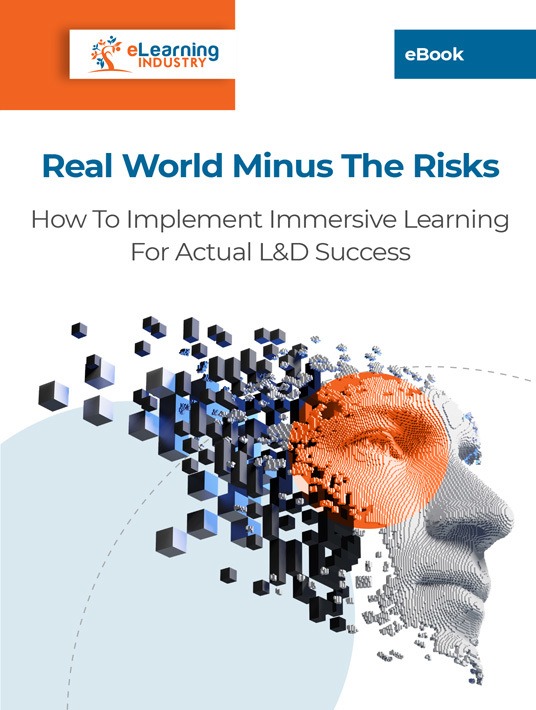Choose The Right Immersive Learning Approach For Your Online Training Strategy
Employees pick up lessons along the way. Every workday brings the opportunity to expand their experience and build vital skills. However, this shouldn’t compromise your brand image or lead to compliance penalties. So, how do you encourage them to take risks and learn from them without putting your profits in peril? The solution is AR or VR training to immerse them in the situation and identify performance gaps. In some cases, both IT techniques are suitable for boosting engagement, interactivity, and real-world application. These 7 tips can help you choose the best immersive learning approach for your online training strategy. Is VR or AR training the right fit for employee preferences, L&D objectives, and budgetary constraints?

1. Identify Key Performance Behaviors
You need to know which performance behaviors, challenges, and gaps you’re assessing to choose the right immersive learning approach. Do you want to test employees’ interpersonal and communication skills? In which case a VR simulation gives you the power to incorporate subtle verbal nuances and body language cues. Or are you trying to gauge their level of product knowledge? AR training can help you quickly evaluate how much they know on the job, no headsets involved. You must determine the overall outcomes, online training objectives, and behaviors you need to reinforce before selecting your Mixed Reality technique.
2. Assess Employee Preferences
Do your employees prefer to access online training content on their mobile devices? Do they need convenient online training resources that travel with them? Or do they want the full immersive online training experience, even if it takes them out of the real world for a short time? Employee preferences, expectations, and personal goals are a crucial part of the decision-making process. What do they need to get from the online training experience and how can you boost staffer engagement? What is their primary source of motivation and how can you mitigate distractions?
3. Evaluate Your VR Training Budget
Of course, price is also a consideration when choosing the right immersive learning strategy for your organization. How much can you spend on new online training content creation, devices, eLearning authoring tools, and an LMS that supports interactive online training resources? The cost is often steeper for VR resources as opposed to AR training content simply because you need special equipment to facilitate the online training experience, such as headsets and VR software. However, you can reduce spending by repurposing existing assets or even outsourcing to an eLearning content provider.
4. Look At Your eLearning Toolbox
Do you already have the necessary eLearning authoring tools to develop AR and VR training resources? If not, you need to invest in a new platform that can handle that level of immersion, such as rapid eLearning authoring tools that feature eLearning templates, themes, and interactions. This means a whole new learning curve for your team and another round of eLearning vendor vetting. This is another reason why many organizations choose to outsource AR training development. They don’t have to worry about selecting new eLearning software and mastering its features. Plus, the eLearning content provider already has the expertise and experience you need to enhance the immersion.
5. Consider Existing Support Online Training Resources
Another area to check is your online training library. Do you have online training resources you can reuse for AR or VR training? For example, simulations or 360 video demos featured in your performance management repository. Or even recorded webinars that can be viewed in a virtual theater or conference room. Creating online training content from the ground up can be costly. But you can ease the financial strain by gradually rolling out AR/VR training resources derived from existing assets. Just make sure the online training objectives are still relevant so that employees connect with the themes and personal challenges. For instance, the presenter in your webinar uses dated jargon that distracts corporate learners instead of helping them find meaning.
6. Find Hidden Online Training Gaps
One of the most effective ways to determine whether AR training or VR training is the best solution is to identify current pain points. What does your online training strategy lack and how can you address these core issues with Mixed Reality learning? Do you already have serious games and other AR assets but need to take them to the next level of immersion? Do employees find it challenging to bridge the gap between theory and real-world application? What’s missing from your curriculum and how does immersive learning fit into the master plan? Conduct a TNA to pinpoint areas for improvement, then weigh the pros and cons of AR and VR based on your use case.
7. Meet With eLearning Content Providers
Schedule a meeting with VR and AR training content providers to get their insight. Outline your corporate eLearning project scope, budget, and online training objectives so they can evaluate the big picture. Do they think it is more cost-effective to hold off on VR and gradually rollout AR training for your team? Or should you dive right into VR training to mitigate compliance risks and improve performance behaviors from day one? Should you launch a BYOD strategy to cut costs? Which online training resources do you already have, and can the eLearning vendor utilize them to reduce eLearning development time?
Which immersive learning approach is right for your organization? There’s no simple answer, as it all depends on your current gaps, outcomes, and online training objectives, as well as the employee preferences and implementation timeline. Implement these tips to create a Mixed Reality strategy that boosts engagement without breaking your budget. You can also take the middle route by combining VR and AR to suit different online training needs. For example, JIT support could be reserved for AR, and compliance simulations could fall under the purview of Virtual Reality.
A Mixed Reality training strategy doesn’t have to drain your organization’s resources or make you go over budget. Download the eBook Real World Minus The Risks: How To Implement Immersive Learning For Actual L&D Success, and discover how you can benefit from incorporating immersive learning into your online training program. Provide an engaging training experience and boost your employees’ confidence with a Mixed Reality training solution.

